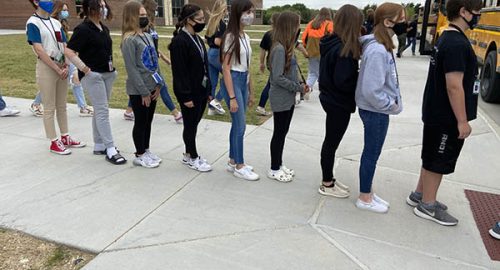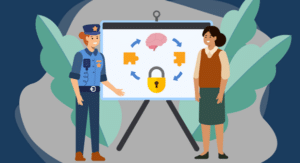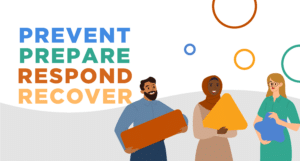Remote learning and physical distancing have made it harder for schools to train students and staff on emergency protocols and response. As schools reopen, leaders must re-prioritize K-12 school safety drills to ensure their school communities can confidently respond to any situation. Experts also warn we may see an increase in on-campus threats and violence, making it even more essential that our students, teachers, and staff know how to keep themselves—and their peers—safe if an actual crisis occurs.
Dr. Jaclyn Schildkraut is the Associate Professor of Criminal Justice at the State University of New York Oswego and one of the nation’s leading mass and school shootings researchers. In a recent Raptor webinar, Dr. Schildkraut summarized her research and shared tips on how schools can improve their school drills.
Are Drills Effective?
Lockdown drills have been a staple to school safety since the Columbine tragedy in 1999. Today, 95% of U.S. public schools conduct lockdown drills, but there is very limited research on the impact these drills have on participants and if these drills are truly helping keep people safe in an actual crisis.
Dr. Schildkraut partnered with the Syracuse City School District after the Parkland tragedy to analyze the effectiveness of lockdown drills. She surveyed the principals across the district’s 30 schools and discovered that, although each school met the state’s mandate of four lockdown drills per year, they were all conducting the drills differently.
Her team conducted lockdown drills at each of the 30 schools. Basing the lockdown procedure on the Standard Response Protocol from The “I Love U Guys” Foundation, Dr. Schildkraut assessed each classroom’s performance based on if they:
- Secured their classroom doors
- Shut off the lights
- Kept students and staff out of sight and quiet
- Answered the door when Dr. Schildkraut’s team knocked during the drill
Dr. Schildkraut and her team completed multiple training sessions with the district students and staff, followed by additional drills over a period of years. Here are the results:
- Secured Classroom Doors: In the first drill, 87% of staff secured their classrooms doors, compared to 88% in drill 6.
- Shut Off the Lights: Only 58% of staff turned off the lights in drill one, compared to 97% of staff in drill 6.
- Out of Sight: 55% of staff kept students and themselves out of sight in the first drill, compared to 97% in drill 6.
- Door Knocks: Nearly 40% of teachers opened the door during the first drill, compared to 2% in drill 6.
Overall, when analyzing for a perfect score on all four components, only 28% of classrooms had a perfect score in drill one, compared to 83% having a perfect score in drill 6.
Why are Drills Important?
According to Dr. Schildkraut, the main function of drills is to build muscle memory. She says, “in an actual emergency, things are very stressful, and the first thing that goes is our cognitive functioning. Our minds go blank and our bodies do what they’re trained to do… it’s like we go on autopilot.”
Her research found that the more students and staff practice, the more they can get into the habit of automatically—and most importantly, correctly—responding to the emergency. Drills also help identify any issues students and staff need to improve.
She continues to expand on the importance of all staff members participating in the drills. “An emergency is not going to discriminate based on what role you have or what task you’re trying to get done,” Dr. Schildkraut says. In the initial drills, she found that some staff members, particularly janitorial and kitchen staff, would continue to work through the drills instead of participate. All staff need to participate because students can be anywhere—including the lunch line or in the cafeteria—when a lockdown is called. These staff members will have to know what steps are needed to keep these students safe, and they can only know this if they are actively practicing with the school.
Are Drills Harmful?
The national news has highlighted how some drills traumatize teachers and students with realistic simulations that invoke fear, trauma, or stress. Examples of realistic simulations that schools have used include firing blank rounds of ammunition; having strangers in masks trying to enter locked classrooms; using special effects like smoke or fog to cloud the hallways; covering students with fake blood; and having police in full tactical gear with weapons storm the rooms.
In her research, Dr. Schildkraut found that when drills are age-appropriate and based on best practices, they do not create trauma or increase anxiety.
When considering students with special needs, it’s important to collaborate with teachers, school psychologists, social workers, and other community partners to plan effective drills for these students. In her research, Dr. Schildkraut found it’s imperative to not only determine each student’s needs, but to also figure out how to accommodate each need during the entire drill.
How has COVID-19 Impacted School Preparedness?
COVID-19 forced schools to immediately respond to its threats and impacts. Consequently, many schools de-prioritized drills and emergency preparedness.
“Unfortunately, as society is returning to normal both within and out of schools…extreme mass violence is also returning,” Dr. Schildkraut explains. “We have to be mindful of not only maintaining the integrity and that skill mastery that we’ve spent the time building, but also the reality that this could still happen in any one of our schools.” Some ways schools can achieve this is by requiring the school community to review training procedures and to go through training at the beginning of the school year.
Will we see an Increase in Violence as we Return to Normal?
Based on her research, Dr. Schildkraut recommends everyone be prepared for an increase in violence. “One of the reasons that we’ve seen this pause [in mass shootings] so to speak, is because of the removal of opportunity. When we look at mass shooters, they are individuals who are trying to cause extreme collateral damage in areas where a lot of people are congregated. Subsequently, with much of our everyday lives shifting remotely, that opportunity has been removed. Now that we’re seeing…more people are out in public and resuming normal activities, it’s sort of reopening that access, if you will, to these events happening more.”
How Do We Know Our Drills are Effective?
There is not a way to ethically test the effectiveness of a drill for an actual emergency. School do not set buildings on fire to see how a fire drill works, for example—just like they would never have an active shooter to test a lockdown drill.
The next best thing, Dr. Schildkraut says, is to practice drills in a controlled environment to see what works and what needs to be improved. After each drill, staff and students should be encouraged to provide feedback and your safety team should immediately debrief. To assess your drills well, schools need a method of tracking drill data and creating comprehensive reports.
“I encourage everybody to develop a school safety team that [evaluate the drills]….Make sure that you’re identifying the areas of concern, but also the areas of improvement,” Dr. Schildkraut says. “One thing that we’re really cognizant of is we don’t want to only tell you what you’re doing wrong. We want to tell you what you’re doing right help to reinforce those behaviors as well.”
How Can We Conduct Drills During COVID-19?
It’s still possible—and important—to conduct drills to create muscle memory and test your processes. The way you conduct drills depends on your school size and how many students are in each classroom. As an example, Dr. Schildkraut revised her drill process during the pandemic. Originally designed for full groups, now teachers split their classroom rosters into four groups. Each time there is a drill, a different group would participate. The group of participating students “would go through the full practice of moving over into the safe location while still being able to be spaced out in the room. The remaining students would remain at their desks and watch.” Teachers would debrief with all students after the drill and remind them that in an actual emergency, everyone would participate in the response efforts.
“There are also other ways,” she continues. “Things like tabletop exercises during staff meetings, online training modules…we want everybody to have refresher training every year…With the students, they are now getting [refresher training] in their classrooms through video training, versus being all together in the cafeteria auditorium” where they cannot physically distance.
Learn More from Dr. Schildkraut
“I cannot underscore how important it is to keep our skills fresh and be prepared for any emergency,” Dr. Schildkraut says.
We cannot predict emergencies, but the more your school community is trained to respond, the less chaotic, and therefore the more successful, your emergency response will be. This all hinges on how well you conduct and learn from your drills.
Raptor Emergency Management includes Raptor Drill Manager, which helps districts empower their teachers, students, and staff to confidently respond to any emergency. With Raptor, you can schedule drills and track compliance; receive automatic notifications before upcoming drills; quickly verify each building’s drill activity; and analyze reports to see what is working and where you need to improve performance.
Watch the on-demand webinar to hear the full conversation with Dr. Schildkraut or contact Raptor to set up a personalized demo.





